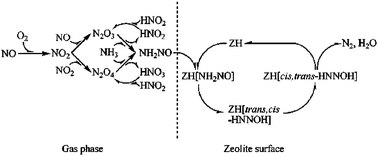New insight into selective catalytic reduction of nitrogen oxides by ammonia over H-form zeolites: a theoretical study†
Abstract
Density functional theory calculations were carried out to investigate the reaction mechanism of selective catalytic

* Corresponding authors
a
School of Chemistry and Chemical Engineering, Institute of Theoretical and Computational Chemistry, Laboratory of Mesoscopic Chemistry, Nanjing University, Nanjing, People’s Republic of China
E-mail:
shuhua@nju.edu.cn.
Density functional theory calculations were carried out to investigate the reaction mechanism of selective catalytic

 Please wait while we load your content...
Something went wrong. Try again?
Please wait while we load your content...
Something went wrong. Try again?
J. Li and S. Li, Phys. Chem. Chem. Phys., 2007, 9, 3304 DOI: 10.1039/B700161D
To request permission to reproduce material from this article, please go to the Copyright Clearance Center request page.
If you are an author contributing to an RSC publication, you do not need to request permission provided correct acknowledgement is given.
If you are the author of this article, you do not need to request permission to reproduce figures and diagrams provided correct acknowledgement is given. If you want to reproduce the whole article in a third-party publication (excluding your thesis/dissertation for which permission is not required) please go to the Copyright Clearance Center request page.
Read more about how to correctly acknowledge RSC content.
 Fetching data from CrossRef.
Fetching data from CrossRef.
This may take some time to load.
Loading related content
